5 May 2018.
It’s a family affair. Even the littlest are dressed in happi jackets.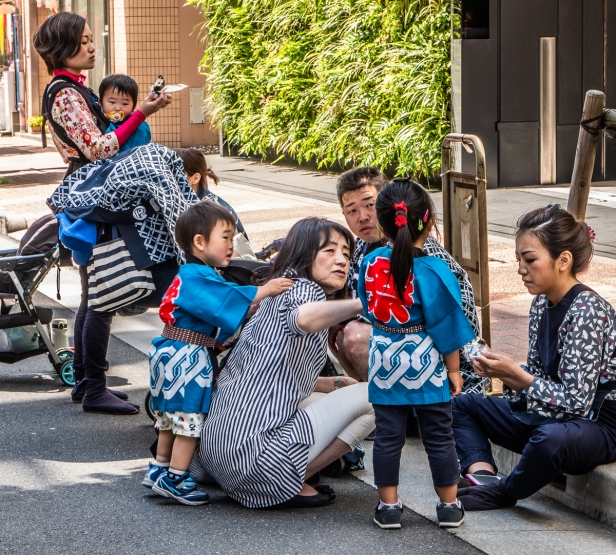

It’s a community affair – just about the entire neighbourhood attends: probably about 200 people. The elders of the shrine are there,
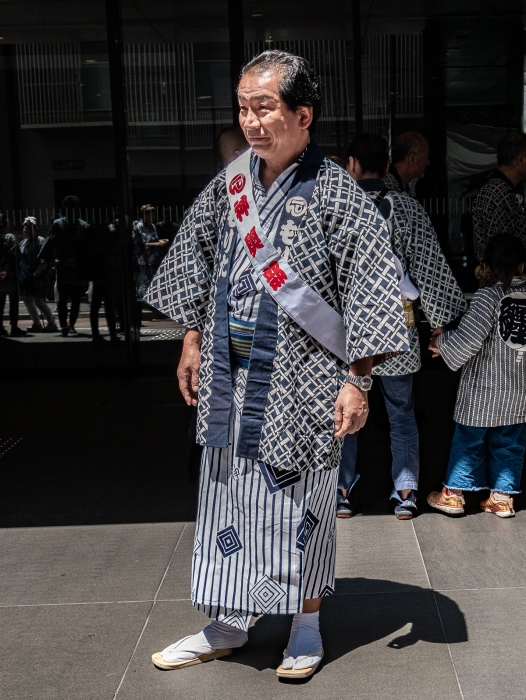
and the priest,
and the burley men who will carry the mikoshi. Some of the men wear long pants under their happi jackets, some wear shorts, and quite a few wear almost nothing at all.
And then there’s us. We are an eclectic group of about twenty staying at the Sakura Hostel in Jimbocho, in central Tokyo, and we have been invited to take part in the local annual Shinto ritual. We must be dressed correctly for the occasion so we’ve all been loaned a happi jacket and light-weight jika-tabi shoes.

The ritual is similar to, though much smaller than that at the Kurayami Festival in Fuchu, which is one of the biggest festivals in Japan.
In the grounds of the Shinto shrines there are small wooden “houses” called jinja. It is here that the gods, or kami live. The kami are like nature spirits, for wind, rain, mountains, and rivers. There is also a kami of fertility, and others for concepts and ideas that are important to everyday life, such as marriage and affluence. Once a year the kami are taken on an outing through the streets – to bless the neighbourhood of the shrine, and to bring good fortune for the year. The kami are carried in elaborate golden mikoshi, or portable shrines. They are ceremonial versions of the small wooden houses in the grounds of the shrine where the kami stay for the rest of the year. The mikoshi are as often as not referred to as omikoshi. The prefix “o” in Japanese is an honorific, added to show honour and respect, and is the more formal term. To the Japanese the addition of the prefix adds a kind of beautification to the word, and to the object.
Dressed for the ceremony I go out into the street and watch as the crowds gather. Lined up ready to go are a large golden mikoshi, a much smaller mikoshi, and a taiko drum on a decorative wheeled cart.

Leaning against the bigger mikoshi are two large oval-shaped paper lanterns on long poles.
We are taught a chant and clapping rhythm, and encouraged to participate in carrying the mikoshi.
More and more people arrive until it is quite a big crowd. There is an amplifier and microphone and the priest is introduced. He speaks for a while, perhaps a kind of sermon, and a request for the area to be blessed with peace and affluence.
At last it is time to go. The big lanterns on poles lead the parade, followed by the mikoshi, with the taiko drum bringing up the rear. About thirty people are required to carry the big mikoshi. It’s heavy! I don’t help. For one thing I’d rather photograph the event, but more pragmatically I’m just not tall enough to be of any use.
Through the streets we all go stomping and clapping and chanting. The kami are paraded in style in their splendid gilt mikoshi. The entire neighbourhood is alerted to the spreading of good fortune.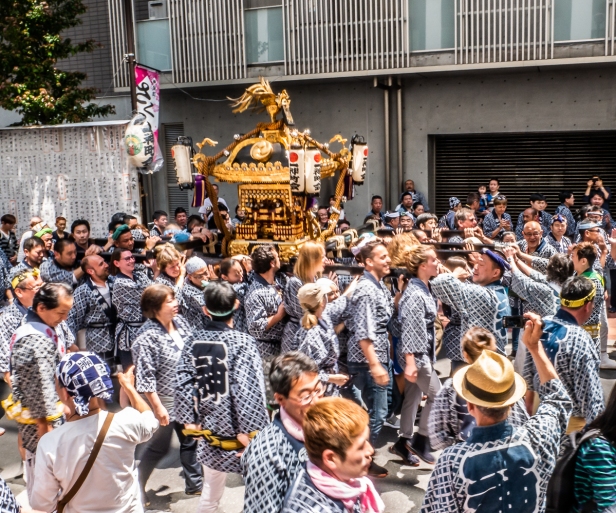
Eventually we end up back where we started in front of the hostel.
And then there is food! A veritable feast! Chicken, sushi, cake, pesto penne, carrot and cucumber sticks, and more, as well as beer and iced matcha green tea.
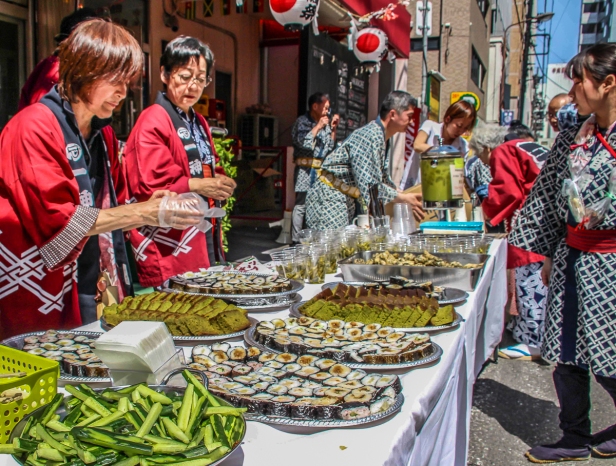

I go into the dining room of the hostel and there is even more. The place is overflowing with food. And it is all so good. I especially like the sushi that are filled with pickled something. I have no idea what it is. I tell people who work at the hostel how much I enjoy it. The next day when I’m checking out they offer me a package of the pickles, but alas I can’t take it as I’ll still be travelling for another five weeks.
Later that afternoon I ride the subway and a train out to Fuchu for the grand finale of the Kurayami Matsuri at Ōkunitama Shrine.
A police tower overlooks the very convenient concrete-block fence that I stood on yesterday, so I know it’s not worth going back there. If I stand on the fence I’ll be told to get down. If I get down I’ll be at the back of the crowd and not able to see anything.
I’m not sure what to do. I wander down the long pedestrian walkway that leads to the shrine. The parade will come down this walkway. People are seated on either side in what is clearly VIP seating. Then quite close to the grand wooden doors that lead to the inner courtyard of the shrine I see a small space on the curb next to a couple who’ve set up tiny stools to sit on. They graciously make space for me and I have my spot. Yesterday I watched from the street end of the walkway. Today I watch from the opposite end.
At first I watch the parade backwards as participants file down the walkway and enter the inner courtyard.
Groups of men with lanterns,
priests in their sumptuous robes,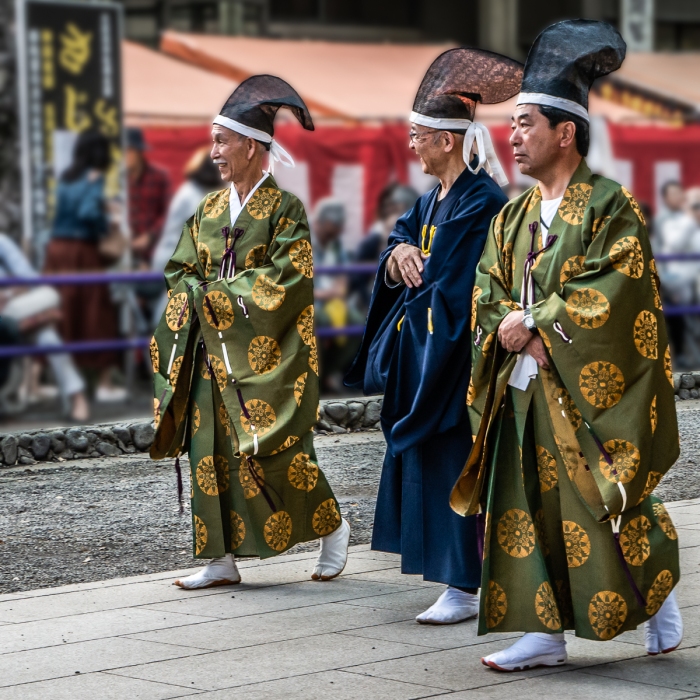
young men and women carrying huge long wooden poles, chanting and clapping as they go,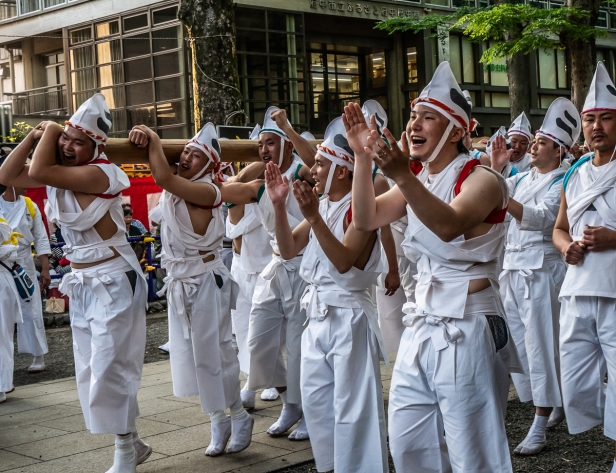
and others who gather in groups and dance around and around in wild circles.
Hundreds file by, each no doubt with a task in the parade to come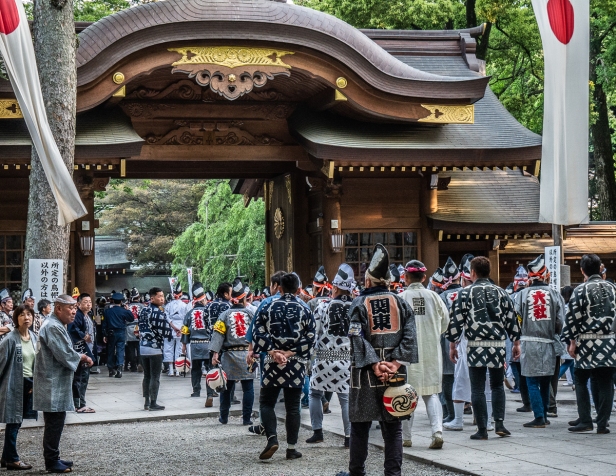
until at last the huge imposing doors are closed and many others wait outside.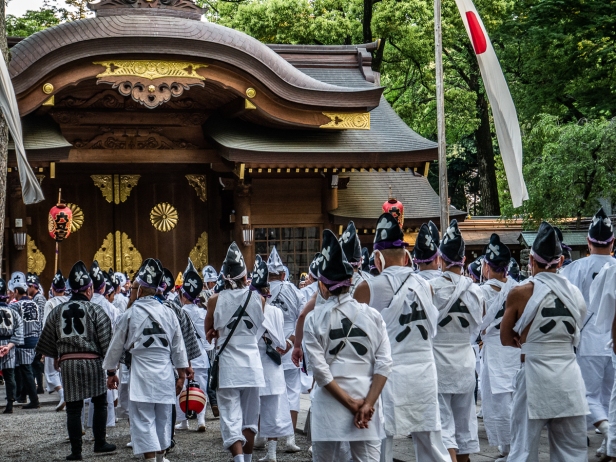

The space in front of the doors is cleared and dignitaries arrive. There are speeches.
And then it begins.
The doors open and the first group emerges.

They are followed by musicians playing, on traditional reed instruments, the haunting music that is native to the Fuchu area.
More priests emerge carrying tridents, lanterns, banners, and the symbolic shishimai lion head, and pushing ceremonial wheeled carts.
And now at last it is time for the drums. Six gigantic taiko drums, some of the biggest in Japan, are paraded through the streets to purify the area. Many years ago the drums would battle with each other so it was an advantage to have a big drum. And so they made bigger and bigger drums until they reached the size they are today.
The first comes into view and you can see the men on top ducking to fit beneath the doors to the shrine.
All the while a man is pounding on each side of the drum, throwing his full body weight into the task. Everyone is chanting the now familiar chant eeZAA eeZAA eeZAA eeZAA over and over. The chant and the thunderous pounding fill the air.
The first drum comes, and the second,

and more and more until all six have emerged and moved on down the walkway.
The energy created by them is so powerfully charged that I am shaking with excitement, just as I was the night before.
After the drums come the mikoshi.

These are not the mikoshi of the local ceremonies such as I had attended that morning. These mikoshi are enormous and require seventy to eighty men to carry them. And the men don’t simply walk. They want to shake up the kami so they jog while chanting, and weave from one side of the walkway to the other. The entire thing – seventy or more men carrying on their shoulders a gilded shrine that weighs a ton or more – moves slowly as one large beast out to the street and through the town jogging, chanting, shouting, waking the gods. Many more walk alongside to relieve those carrying the weight.
There are eight mikoshi. I stay for three. Now is the time to find a way out of there. I can’t go down the parade route so I squeeze behind into the area where all the restaurants have been set up.
The food court is large and busy but not impossible to move through. I make my way to the street, and then move with the crowds down the street. I’m hoping to get to a point where I’m allowed to cross the street since it’s the only way I know to get to the station.
The crowds get more and more intense. I find myself in a bottleneck literally squished body-to-body and unable to move. Without the thought actually even forming I know I have to bulldoze my way through. No one is moving or can move. I suddenly charge forward and force a way through about two metres or so to the other side of the bottleneck.
Finally free I make my way onto an upper pathway to the station. As I walk I can hear the noise, the chanting and shouting, and lifting the corner of a tarp preventing a view of the street below I find I can see down and get one last glimpse of the mikoshi as it moves through the town.
It will rest at a special place overnight and at four the next morning it will be carried back to Ōkunitama Shrine until the same time next year.
Next post: A day trip to Nikko and the very beautiful Toshogu Shrine.
All words and images by Alison Louise Armstrong unless otherwise noted
© Alison Louise Armstrong and Adventures in Wonderland – a pilgrimage of the heart, 2010-2018.

What an incredible experience Alison. I could feel the excitement and fervour pulsing through your words and photos. This will be a day you will never forget. Did you know this was going to happen or were you just in the right place at the right time? Being part of these cultural experiences is what makes travel so addictive
LikeLiked by 2 people
Thanks so much Pauline. I think perhaps it will be a day I won’t forget along with the first day I spent at Kurayami; it was a really amazing festival. I did know about it. It actually goes for a week, but the final 2 days are the biggest/most important so I made plans around attending for those 2 days. Whenever I’m travelling one of the things I always research is festivals. There were actually 6 festivals on in the 2 cities I was visiting during only 18 days in Japan. I went to 5 of them. Local festivals are one of the things I love most about travelling and Japan has an estimated 20,000 per year!
Alison
LikeLiked by 1 person
Certainly plenty of festivals to chose from. What a good idea to build your trip around the festivals.
LikeLiked by 1 person
Loved this post, the pictures are incredible. The last photo might be one of my favourites ever!
LikeLiked by 1 person
Thanks so much Jamie.
There’s a setting you can change on WP that will turn your name (jamiechancetravels) into a link to your blog.
I just followed you on insta.
Alison
LikeLike
Thank you! I’ll have a look for that see if I can sort it!
Jamie
LikeLiked by 1 person
Simply spectacular!
LikeLiked by 2 people
Thanks so much Tracey. It really was!
Alison
LikeLike
Recomended postt
LikeLiked by 1 person
Thank you!
Alison
LikeLike
Just stunning. You people portraits are so beautiful too.
LikeLiked by 1 person
Thanks so much Tish. It was just about the most exciting festival I’ve been to. Those drums were so powerful.
Alison
LikeLiked by 1 person
Oh yes, Japanese drums. Resonate right through ones nervous system and beyond!
LikeLiked by 1 person
I think I have mentioned here or on my blog that I’m not a huge festival person; I don’t love crowds and often feel I am an impostor when I’m in another culture and country. But these?!?! These look spectacular, and the ability to participate with the hostel’s help would have pushed me to stay and be part of it. Add the huge drums and the fact that it feels more like a parade, and I’m in for sure! (Oh, and the food … wow is all I can say.) Your descriptions of the mikoshi and their carriers are alive with the motion and emotion of the day – beautiful!
LikeLiked by 1 person
Thanks Lexie. Being able to convey a sense of the aliveness of an event is important to me. I love festivals, but I must admit I pick and choose how much of one I’ll attend, always giving myself needed down time, hence only staying for three of the mikoshi. It had been a long day and I needed out of there. I have no doubt the mikoshi parade and attendant revelry went on for hours, and then started again early the next morning. I just don’t have that kind of staying power. Also most festivals I’ve attended have some part of it that’s a parade and that’s usually what I go for. I wouldn’t have missed those huge drums for anything!
Alison
LikeLiked by 1 person
Hi, am an avid follower of your blog, please follow my blog https://www.lifidigital.co.ke
LikeLike
Thank you for following and reading Erick. I appreciate it. Unfortunately the subject matter of your blog does not interest me that much. Chuckle, it’s guy stuff!
I guess there’s no easy way to say this but it’s never a good idea to ask someone to follow your blog. Just saying . . . .
Alison
LikeLike
beautiful community celebration!
how wonderful to be welcomed
to participate 🙂
LikeLiked by 1 person
Lucky to be included
and welcomed
into some real local culture.
Strong sense of community
at both festivals.
Japan loves and honours its heritage.
Alison
LikeLike
As I’ve mentioned before Alison I am not a fan of crowds but I do love the idea of being part of the smaller celebration. Your photos are tremendous and I think I can almost hear the roar of the scenes
LikeLiked by 1 person
Thanks so much Sue. Yeah, the crowds were epic that’s for sure. I really did have to literally bulldoze my way through. In doing that I hope I kind of opened up the way for others. The smaller celebration was fun, so glad to be able to be a part of it. The bigger celebration was mind-blowing!
Alison
LikeLiked by 1 person
That overhead shot deserves to be published in a travel publication!
LikeLiked by 1 person
Thank you so much! What a great compliment!
Alison
LikeLike
Another amazing experience. And those drums. I could just feel your excitement!! Did you get to keep the happi jacket?
LikeLiked by 1 person
I just found you in the spam file! Sometimes Akismet gets it wrong.
Yes, it definitely was an amazing experience. I was so excited by those drums I was literally shaking. I’ve never had that happen before.
Sadly no, I didn’t get to keep the happy jacket.
Alison
LikeLiked by 1 person
We attended a Japanese drummer performance at The Queen Elizabeth Theatre in Vancouver once. It was amazing! To see these drums in Japan would be something else.
LikeLiked by 1 person
Your photos convey the energy of the festivals; I love the colors, the traditional patterns, the happi jacket, the richly-decorated mikoshi, the giant drums, and the food! This must have been one of the highlights of your trip to Japan, Alison. There are festivals which I’m not too interested in seeing, but these are definitely worth seeing. Speaking of the mikoshi, I wonder how long it took them to make one. I’ve seen videos of Japanese craftsmen creating among the most delicate and fine carvings. So I’m not surprised to see how beautiful and refined the mikoshi looks.
LikeLiked by 1 person
Thanks so much Bama. It was definitely a highlight! Japanese festivals are amazing. And there are so many of them. About 20,000 per year I’ve read!
All the mikoshi I saw were beautifully made, in that true Japanese tradition of perfection. There is a mikoshi in Vancouver for the annual matsuri held for the Japanese community here. I saw it last weekend and it’s stunning.
Alison
LikeLiked by 1 person
Alison, you had me with your catchy headline…and then your photos, stunning! You really do an exceptional job relaying the feel of these festivals. I wish I had your skill for taking people pictures. The men in the happi jackets with nothing much beneath is quite the look.
LikeLiked by 1 person
Thank you so much Caroline! I’m perhaps a bit intrusive when it comes to taking people pictures. I try not to be, and I have a zoom lens which helps. I’m actually a bit shy about it but I want the shot so do it anyway. It’s a bit of a love/hate thing for me, but in the end getting the shot is mostly what wins.
Oh the men in just their underpants! What a look! It was a bit of a shock, such an unexpected thing to see. I can only assume there is some traditional reason behind it, but there was only the one wearing a thong, and I’m not sure I even deliberately photographed that. I just noticed it when I went through my pics later.
Alison
LikeLike
What’s up with the bare-bottomed men? Does that have any relationship to the festival?
LikeLiked by 1 person
Isn’t that a hoot! I’m absolutely sure it has something to do with the festival. I did google it to see if I could fine out more with no luck. I can only assume it is something traditional. I wish I’d thought to ask when I was there. The people at the hostel spoke English and maybe could have told me about it.
Alison
LikeLike
I’ve been living in Japan for nearly six months and festivals are definitely one of my favourite things here. Hmm, I wonder what it would be like to participate in one. Your article was a great read and I’m looking forward to seeing what you’ll write next!
LikeLiked by 1 person
Thanks Aidan, glad you liked it. The festivals in Japan are amazing aren’t they? I was only there for 18 days and just in Kyoto and Tokyo there were 6 festivals on and I went to 5 of them. Where are you based? Next post is about Nikko – have you been there?
Alison
LikeLike
There is nothing quite like stepping into a new culture and experiencing a tradition like you have described here in both words and photos. Such festivals are great for the spirit ~ and you capture this with your camera, really something else. Your second photo and last photo are my favorites, from the eyes of the kids to the seriousness of the of the festival. Wonderful, Allison, wishing you all well.
LikeLiked by 1 person
Festivals are one of my favourite things about travelling – in a very unique way they let you experience the culture at its most joyful, most committed, and most creative. A festival may not be everyday life, but it definitely puts on display what’s important to the culture. Japan (and its festivals) was a revelation for me. Thank you for your kind words Randall.
Alison
LikeLike
What a great experience of cultural festivals Alison. Luckily you guys got to keep your pants on…Lol… 🙂
LikeLiked by 1 person
Chuckle, yes, lucky we got to keep our pants. I’m sure the no-pants thing is traditional, going way back, but unfortunately I couldn’t find anything about it online. For sure there were quite a few men wearing just underpants (one in bright red!), and the one with his back to us in the photo was wearing a thong, so not completely naked. I imagine even the Japanese would have drawn the line at that lol.
I loved the festivals in Japan. I attended another in Kyoto which I’ll post about eventually.
Alison
LikeLiked by 1 person
Well at least they weren’t completely naked. We do have to respect their traditions…. even it it means with no clothes on 😂😂
LikeLiked by 1 person
Lol, yes we do.
LikeLiked by 1 person
Wow what an experience and such extraordinary photos (as always) Alison! That last photo is breathtaking. I had to laugh at the men’s outfits. Did that one man have any underwear on? You really got to embrace cultural events and festivals on your trip.
LikeLiked by 1 person
Thanks so much Nicole. It was an amazing experience!
He did have underwear on – he was wearing a thong.
Japan is amazing – in 18 days in 2 cities there were 6 festivals that I knew of, and I went to 5 of them.
Alison
LikeLiked by 1 person
Ha Ha
LikeLiked by 1 person
Amazing pictures and insights in Japanese culture.
LikeLiked by 1 person
Thanks rabirius. Japanese festivals are amazing. I’m so glad I took the time to go to this one.
Alison
LikeLike
I could feel the intensity build as I continued to read this post. I am learning so much from your recent travels, realizing just how little I know of the Japanese culture. Although the thought of such large crowds gives me pause, the passion that you describe and the ability to participate in such a special festival made me long to be there. Your photos are nothing short of spectacular!
LikeLiked by 1 person
Thank you so much LuAnn. I was blown away by Japan and would love to go back. I too knew very little about the culture and it was so exciting to discover it. They have a reputation of being a very repressed people – always doing and saying the right thing – but it’s not like that at all – there’s extraordinary creativity there, and really strong community spirit, and such passion for their traditions and festivals. There’s an estimated 20,000 festivals per year!
Alison
LikeLiked by 1 person
You have raised my interest in Japan exponentially!
LikeLiked by 1 person
I love the last capture…so many humans…what and experience you had Alison…and the regalia is so fine too 🤓❤️💫 smiles Hedy
LikeLiked by 1 person
Thanks Hedy. That last capture was really a great stroke of luck, one of those serendipitous travel moments that you could never plan.
It was an amazing experience! So glad I went to it. And yes, the regalia is very fine 🙂
How do get those emojis in your comments?
Alison
LikeLiked by 1 person
I use safari and on my Mac…🧐🤓
LikeLiked by 1 person
I do too so where do you find them?
LikeLike
I love the concept of this festival, I love the ceremonial objects, I love that people in the hotel were encouraged to participate, and I’m once again in awe of your photographic skills. How you could manage so many great images amidst what must have been a really overwhelming experience, is beyond me. At least you were able to break up the day, and duck out at a sane moment, relatively speaking. it was brilliant to lift that tarp and get the parting shot.
Shake those kami!!
I apologize for being so late to the party here, too – September got away from me!
LikeLiked by 1 person
Thank you so much Lynn. I have so much fun photographing things like this. Somehow it enhances the experience for me. It was an overwhelming experience in some ways – the power of those drums was unexpected; I’ve never before had the experience of being so excited I was actually shaking. But it was also so thrilling – getting this close to such a long standing tradition of the local culture is always something special. Breaking up that day was important. I’d spent pretty much the entire day at the Kurayami Festival the day before and was exhausted by the end. Hearing the mikoshi below and finding that I could lift a corner of the tarp was pure serendipity! I only got in a couple of shots before I was caught and told to move on. They’re pretty strict with rules in Japan.
Alison
LikeLike
I can easily imagine shaking from the experience of being near those drums, with all the other intensity. I’m glad photography enhances the experience – it certainly enhances my day, and many others’ days, as you can see above. 🙂 Ripples….
The rule bit I have seen first hand (not there, I haven’t been there, but being around Japanese-inflected zen practice settings a lot. Maybe it has to do with so many people living in a small place: the need for following rules, then letting off steam with activities like this – and the famous salary-man sake drinking.
LikeLiked by 1 person
There seems to be a lot of rule following, and then letting off steam, but I also found the culture generally to be quite stunningly creative, so the rules weren’t restricting that, and the people unfailingly polite. I do think there’s a connection between the rule following and living in a crowded space, but it’s not just that. I went to China, which is equally crowded, right after Japan and it could not have been more different!
Alison
LikeLiked by 1 person
What a fantastic visual account of a Japanese Matsuri. While Japan offers frequent bites of visual delights in amongst the tumult of modern Japan, the concentration of folkloric displays, that come with special holidays, is truly unique and not to be missed. Your photography is spectacular and has captured it wonderfully. I used to live in Nagoya which is still today a bit more laid back than Tokyo, and a city that enjoys its folkloric celebrations, so your post brought back many memories of temple festivals.
I hope to return one day with Peta ~ we have only had 18 hours in Tokyo together. I am afraid that the happi coat with nothing underneath is a look she might want me to adopt…. haha 🙂 Not happening!
Ben
LikeLiked by 1 person
Thanks so much Ben. I was completely bedazzled by the number and fabulousness of Japanese matsuri. I read somewhere that there are an estimated 20,000 festivals per year! I was there for only 18 days and in that time just in/near Tokyo and Kyoto there were 7 festivals, and I went to 5 of them (well I’m counting 2 flower festivals in this).
Thanks re the photos. I was overjoyed to get that final shot looking down on the mikoshi – pure serendipity.
I’d love to go back to Japan and explore more and go to more matsuri. I’ve not been so drawn to return to a country as I have to Japan (well India too – not possible to get two countries more different and yet both seem to call me back). I know I’ve written in other posts about how foreign Japan felt and how it bamboozled me, but it captured my heart and imagination too. I can’t imagine what it must have been like to live there. I’m not sure I’d be up for that though I have Aussie friends who’ve lived in Tokyo for several years and love it, and my sister and her family lived there for 3 years and also loved it.
I hope you get to return with Peta, and that I get to return with Don. As for the bare bum guy – he was wearing a thong at least. Chuckle, I can’t imagine you or Don being willing to sport that look! Nor Peta nor I wanting it 🙂
Alison
LikeLike
Beautiful
It’s a awesome idea to live pleasure of mind by beautiful places.
LikeLiked by 1 person
Thank you so much.
Alison
LikeLike
You definitely had a front row seat! Most interesting was the preparations, and the men getting dressed/undressed. 🙂 Great shot from above at the end. As part of the “International Salon” where I took Japanese and traditional arts classes, I took part in a town anniversary festival in Fuchu in yukata. Women helped us get dressed. It was difficult to walk in geta with the robe tightly pulled around our legs. We did the dance we had practiced up and down the tree-lined street, similar to other local groups each in different colored yukata.
LikeLiked by 1 person
Oh it was so amazing to see the procession right there at the curb. I was travelling solo at the time and getting that place to sit is a great example of one of the advantages of that. And that overhead shot at the end was pure serendipity.
Your experience participating in the town anniversary festival sounds quite wonderful. I love that kind of really immersive activity, and I also love how the Japanese hold so strongly to their traditions and festivals. Such a rich culture.
Alison
LikeLiked by 1 person